Yuening Jenny Jian
REIMAGINING WONDERLAND: THE PREPARE, WEAR, TEAR, AND CARE OF THEME PARK COSTUMES
Summary
This research proposes a new approach to the study of theme parks through interdisciplinary, practice-based research. It utilises art practice as a vehicle for interrogation, inspection, articulation, and communication. Focusing on inclusivity, humanity, and care, the research emphasises mediums’ tangibility, tactility, and materiality. Research methods, including archival analysis, case studies, autobiography, and plurivocity are employed.
The primary objective of this research is to interrogate the concept of utopia in post-modern society and explore potential alternatives. The investigation centres on the life cycle of theme park costumes, examining their journey from design, manufacture to operation and maintenance. By conceptualising theme park costumes as both physical artefacts and philosophical metaphors, the study delves into the intricate nexus of capital, imagery, and human labour within the theme park industry and critically examines the prevailing system of global culture production. The research suggests an alternative future that transcends the boundaries of binary and hierarchy.
Keywords: utopia, theme park, spectacle, costume, labour, culture production
Additional info
Yuening Jenny Jian (简月宁) is a multidisciplinary artist and researcher from Guangzhou, China. Jian's creative practice explores the interplay between capital, imagery, and humanity. She responds to social-cultural phenomena with cross-media experimentation, including textiles, metal, painting, drawing, and installation. Jian’s works investigate the nuances between fictional and real, past and future, as well as utopia and dystopia. Her research employs an interdisciplinary, practice-based approach. It interrogates the notion of binary opposition and investigates artwork’s ability to record tactile memory, embody human labour, and present untold stories. By bringing attention to tactility, serendipity, and fluidity, Jian’s works provide a site for conversation, reflection, and reimagination.
Research Question
Focusing on the life cycle - the preparation, wear, tear, and care - of character costume, I wonder: How do costumes in the global theme park industry mediate utopian fantasy, visual spectacle, and human labour, and how might they serve as catalysts for introspection and re-imagination? Through art practice, I hope to create a narrative ‘about objects made by people, and about people that make objects’.
This thesis seeks to explore the following questions: What underlying mechanisms drive the portrayal of character costume performances within the theme park industry, particularly in shaping individuals’ perceptions of utopian ideals and visual spectacles? How do costumes serve as conduits between the visible and the hidden worlds within theme parks, and what roles do human participants undertake in character costume performances? In what ways can the artistic aspects inherent in costumes capture tactile memories, embody human labour, and present marginalised voices and untold stories to a broader audience? How can innovative making practices foster critical reflection, challenge existing norms, and help envision new possibilities and alternative futures?
Methodology
This interdisciplinary study draws from subject areas, including history, fine arts, humanities, culture studies, communication, sociology, psychology, and philosophy. It concentrates on the synergies between artistic practice and theoretical study, delving into their intersection, interconnection, and interaction. The research methods encompass archival analysis, case studies, autobiography, fictional writing, plurivocity, printmaking, and art installation.
Table of Contents
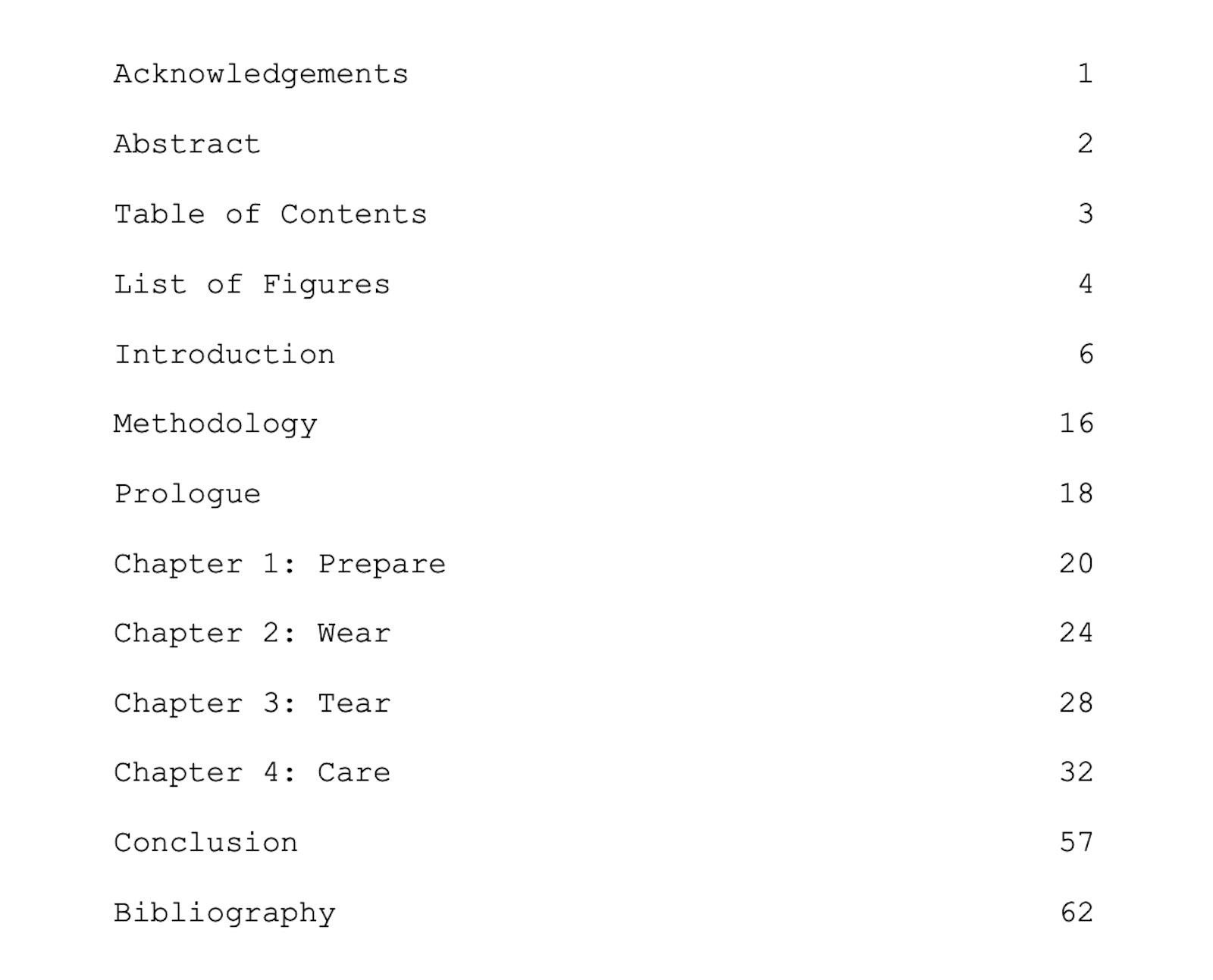
Selected Bibliography
Baudrillard, Jean, The Consumer Society: Myths and Structures (Los Angeles, London, New Delhi: SAGE Publications Ltd, 2016)
Bauman, Zygmunt, Liquid Modernity (Cambridge & Oxford: Polity, 2000)
Benjamin, Walter, The Work of Art in the Age of Mechanical Reproduction (London: Penguin, 2008)
Berger, John, Ways of Seeing (London: Penguin Classics, 2008)
Braidotti, Rosi, Posthuman Knowledge (Cambridge & Oxford: Polity, 2019)
Braidotti, Rosi, The Posthuman (Cambridge & Oxford: Polity, 2013)
Debord, Guy, Society of the Spectacle (Detroit, Mich: Black & Red, US, 1984)
Deleuze, Gilles and Felix Guattari, A Thousand Plateaus: Capitalism and Schizophrenia (London, New York, Oxford, New Delhi, Sydney: Bloomsbury Academic, 2013)
Freitag, Florian, Filippo Carlà-Uhink, Salvador Anton Clavé, Sabrina Mittermeier, Crispin Paine, Ariane Schwarz, and others, Key Concepts in Theme Park Studies: Understanding Tourism and Leisure Spaces (Cham, Switzerland: Springer, 2023)
Fisher, Elizabeth, On Not Knowing: How Artists Think (London: Black Dog 2013)
Halberstam, Jack, The Queer Art of Failure (Durham, NC: Duke University Press Books, 2011)
Haraway, Donna, Staying with the Trouble (Durham, NC: Duke University Press Books, 2016)
Mitchell, W.J.T., Picture Theory: Essays on Verbal and Visual Representation (Chicago, Ill.: University of Chicago Press, 1994)
Mittermeier, Sabrina, A Cultural History of the Disneyland Theme Parks: Middle-Class Kingdoms (Bristol & Chicago: Intellect, 2021)
Robertson, Roland, Globalization: Social Theory and Global Culture (London: SAGE Publications Ltd, 2000)
A Fictional Archive
Synthesising art practice and theoretical study, this practice-based project proposes an innovative approach to theme park and costume studies, one that is interdisciplinary, non-binary, open-minded, and exploratory. It creates a fictional space - a hyperreal reflection of the real world - for speculation. In the context of the theme park industry, discussing original materials can be challenging due to various sensitive factors. However, this does not mean the issues should remain unaddressed and unexplored.
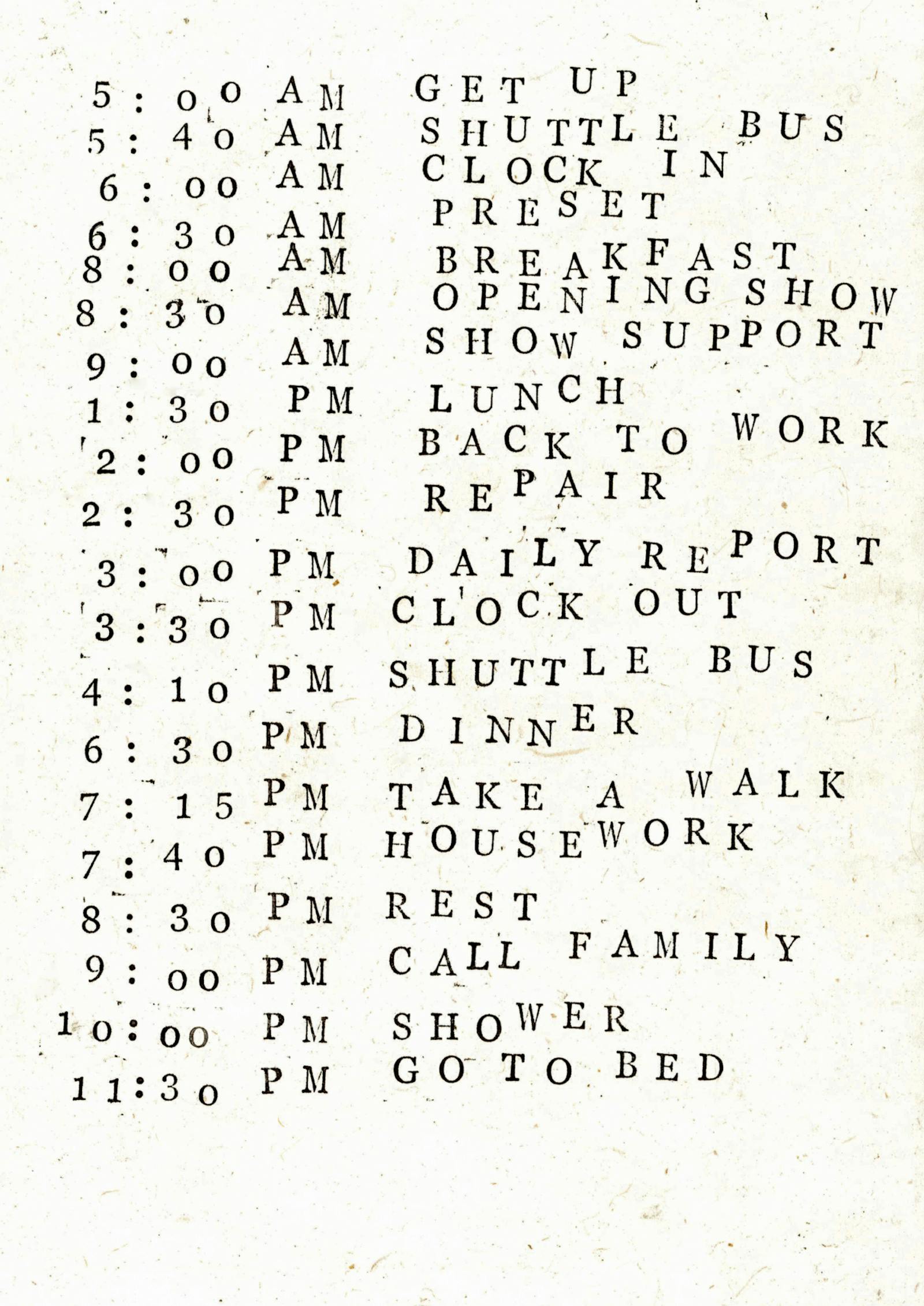
Another Day of Glamour (2024), stamp print on hand-made paper, 27 x 21 cm
Utilising printmaking as a means of archiving individuals’ daily lives, I created a series of prints reflecting the daily schedules of theme park dressers. Immersing myself again in the line schedule, I carefully selected letter stamps from the wooden box where they were organised alphabetically, pressed them on the ink pad, and stamped the seemingly mundane words onto the paper. The letter stamps were lightweight, yet they felt surprisingly heavy as I pressed them firmly onto the paper - a moment requiring precision, control, and pressure.
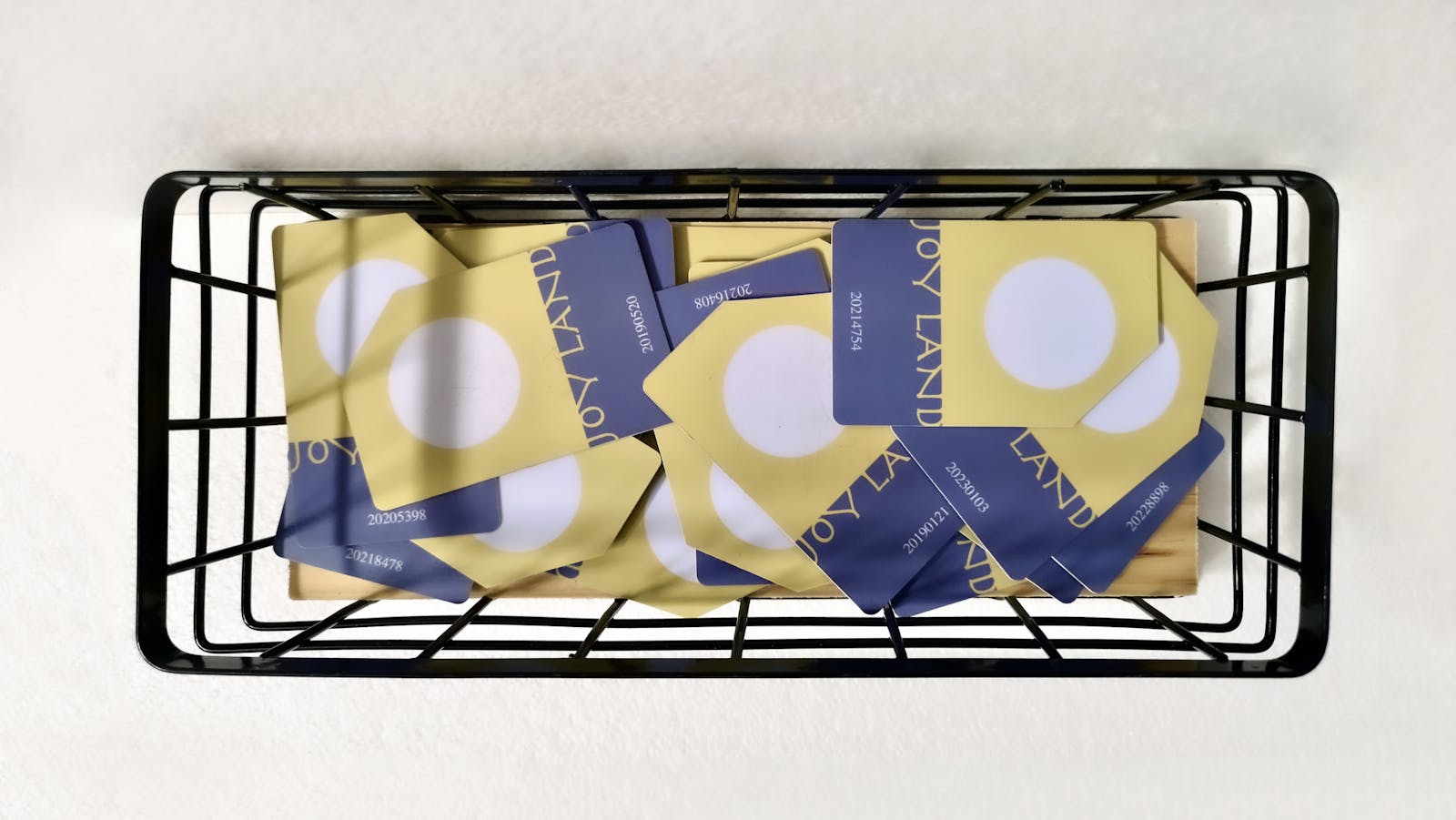
Untitled (2024), printed PVC cards, found iron basket, 10 x 25.5 x 7.5 cm
In response to the high staff turnover rate in the theme park industry, I created an installation featuring fictional staff passes of resigned theme park employees. The purposely distressed cards are placed disorderly in a basket, a file organiser, a cage, or a scrap bin, depending on how you would interpret it. The piece poses several questions: What does it mean to quantify individuals? What happens when the identities of individuals are reduced to simple digits systematically coded by the year and the order of recruitment? How do these abstract digits dehumanise and objectify concrete, actual individuals?
Fabrication Minion
‘Fabric’ serves as a tangible testament to centuries of human labour and ingenuity. However, alongside ‘manufacturing’ and ‘construction’ lies another layer of meaning: ‘fabrication’, a word that denotes ‘lying’, ‘falsehood’, and ‘forgery’, reflecting the darker facets of an industry plagued by deception and manipulation. In building this piece, I collected, unpicked, reassembled, and repurposed, exploring the breadth, depth, complexity, ambiguity, ruggedness, and darkness of denim fabric - a material deeply intertwined with the theme of labour since its origin. The process epitomises what I would call ‘thinking through touching’ and ‘thinking through making’.
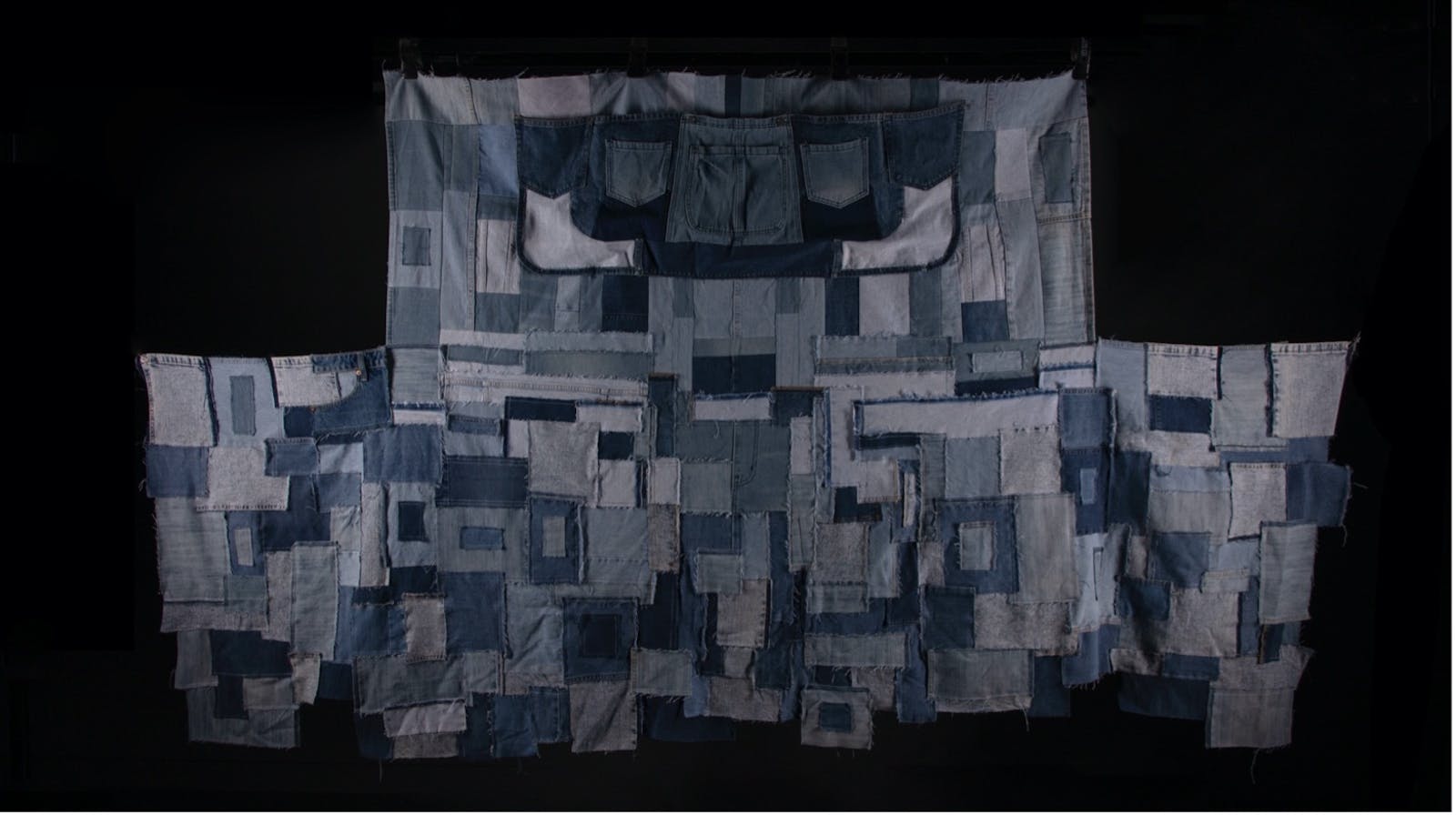
Fabrication Minion - One Side (2024), recycled denim, 200 x 250 cm
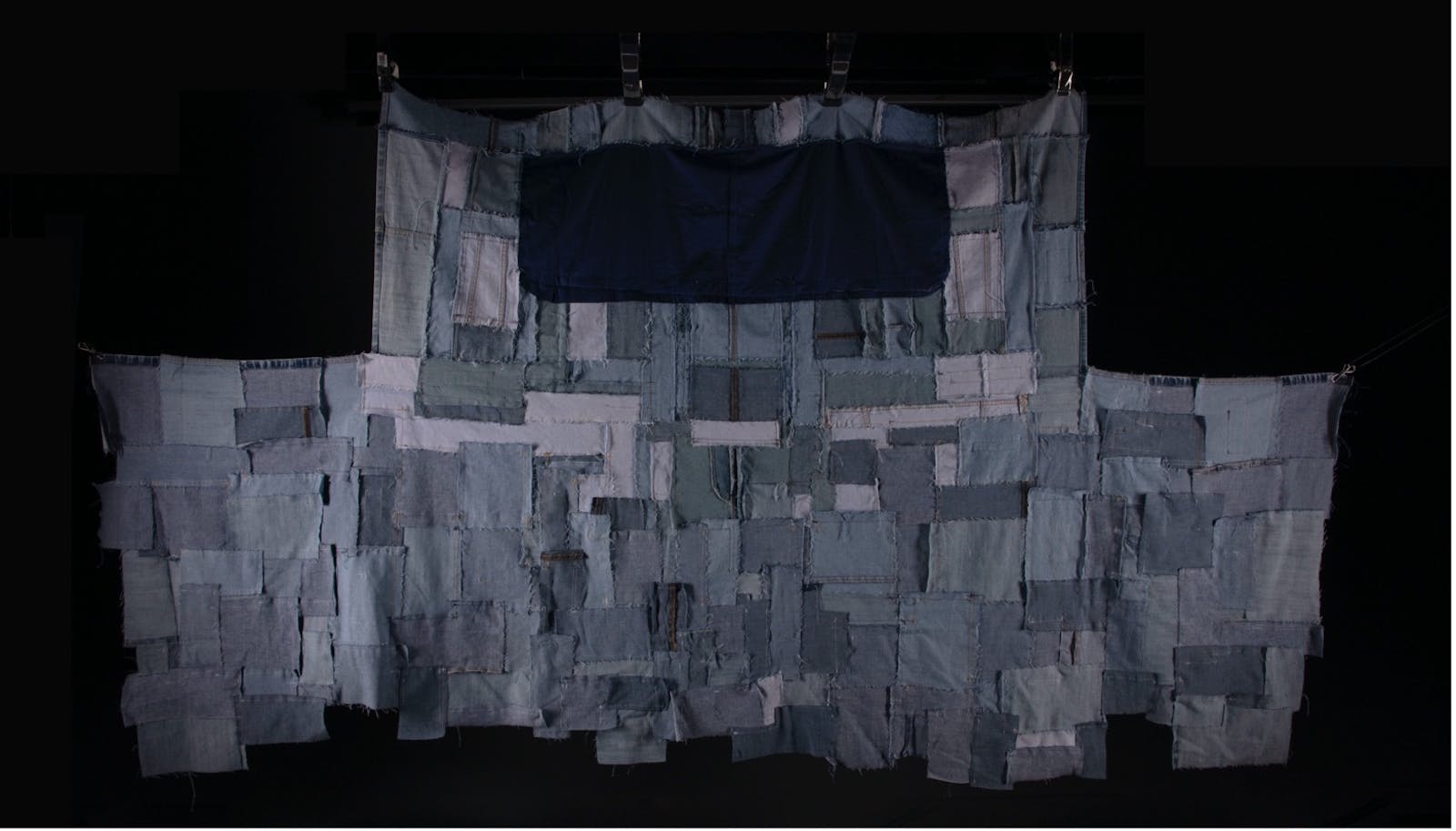
Fabrication Minion - The Other Side (2024), recycled denim, 200 x 250 cm
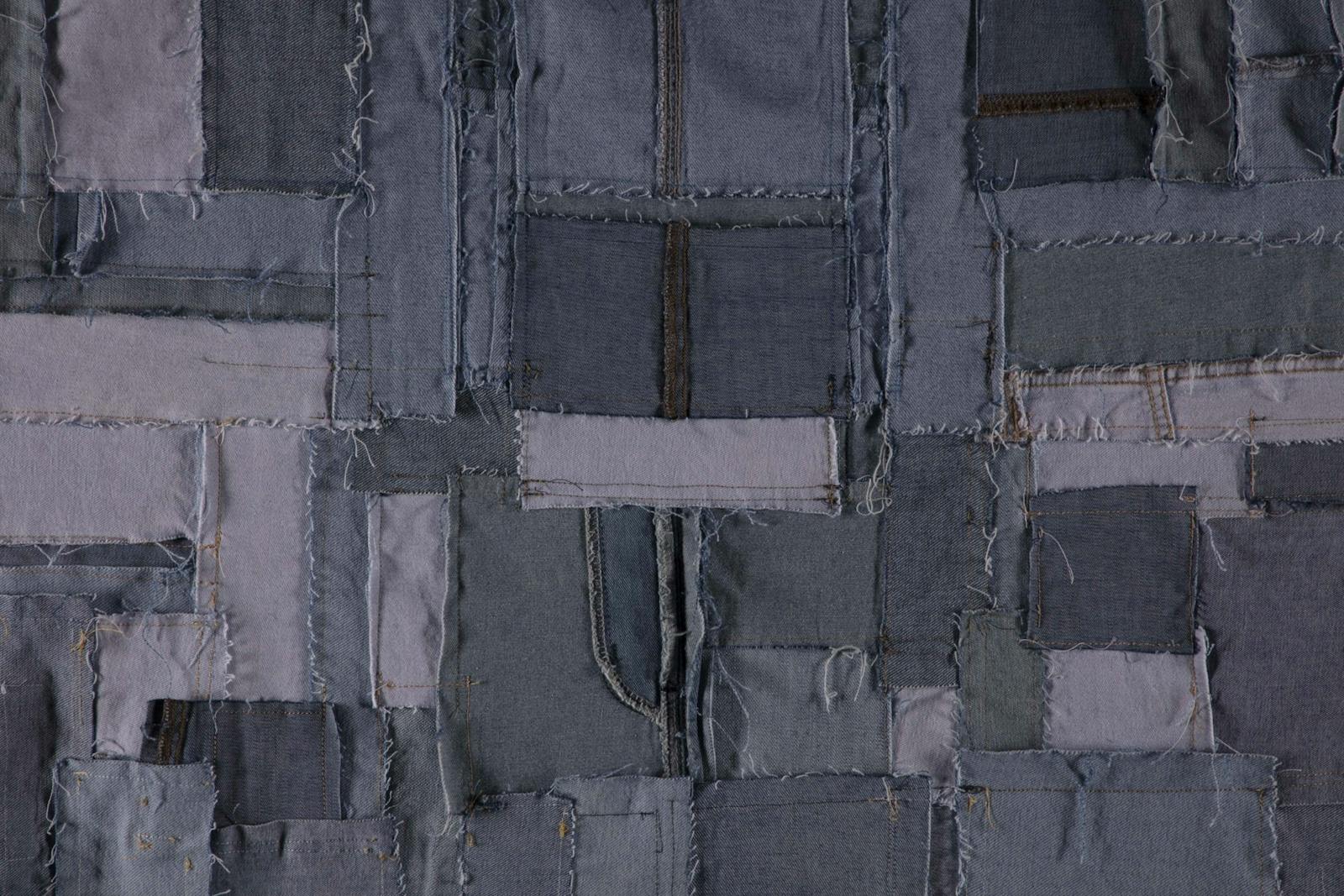
Fabrication Minion - The Other Side Detail (2024), recycled denim, 200 x 250 cm
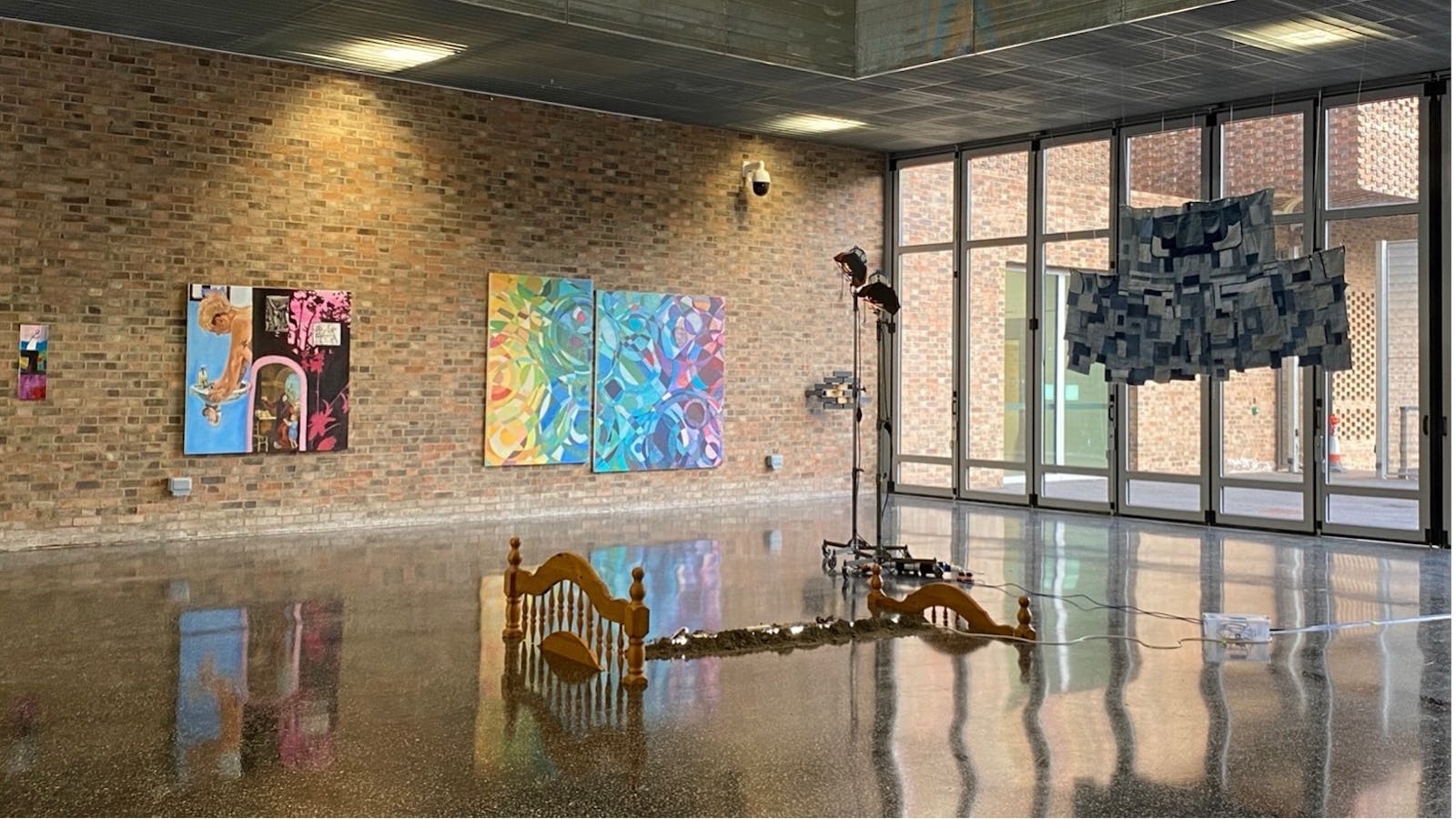
Fabrication Minion (2024) exhibited in Fragments for the Future Exhibition – Stillness, 23 April 2024, curated by Jonathan Miles, The Hangar Gallery, Royal College of Art, London
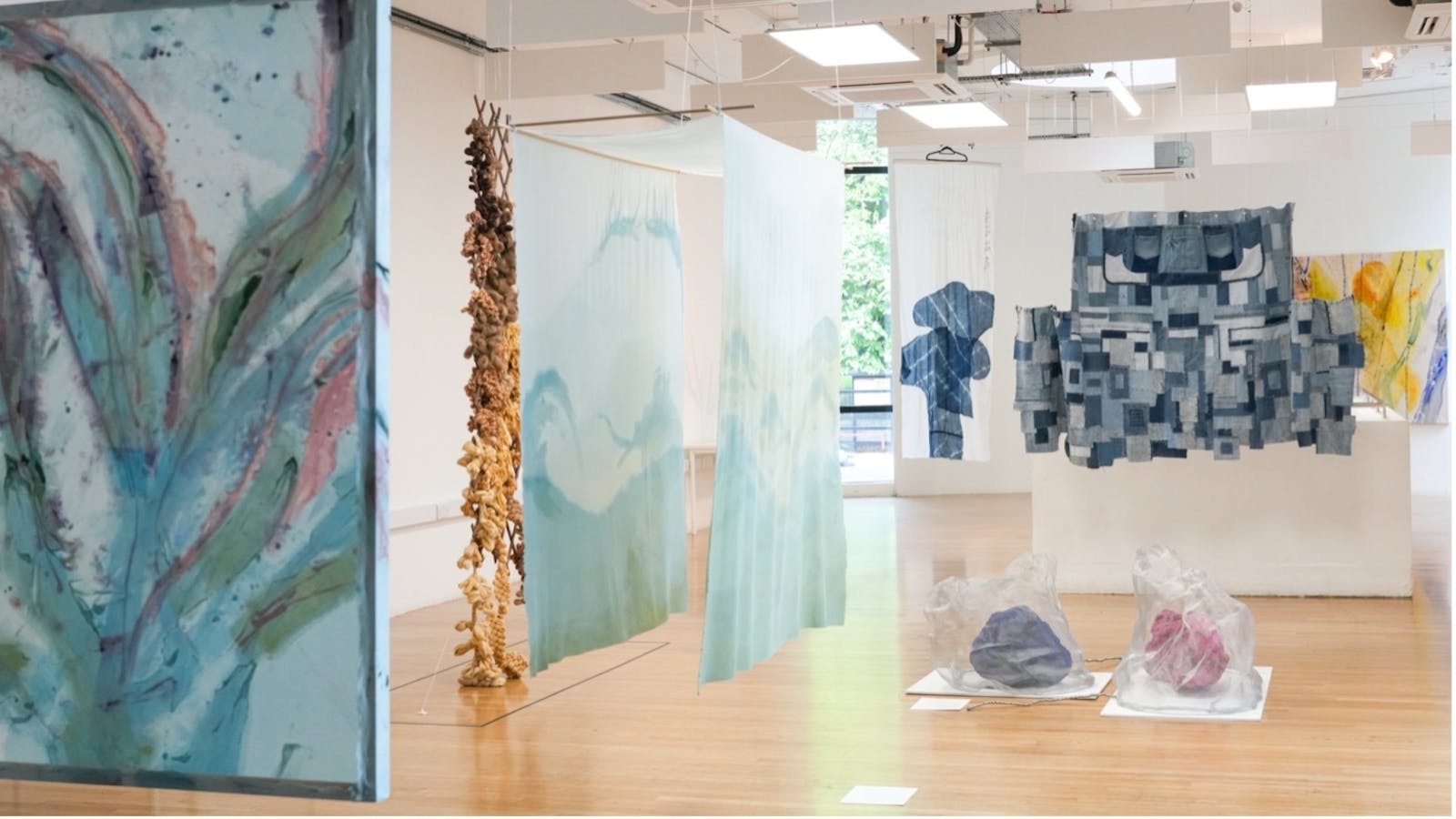
Fabrication Minion (2024) exhibited in Co-creating With Nature Exhibition, 13 May 2024 to 17 May 2024, Upper Gulbenkian Gallery, Royal College of Art, London
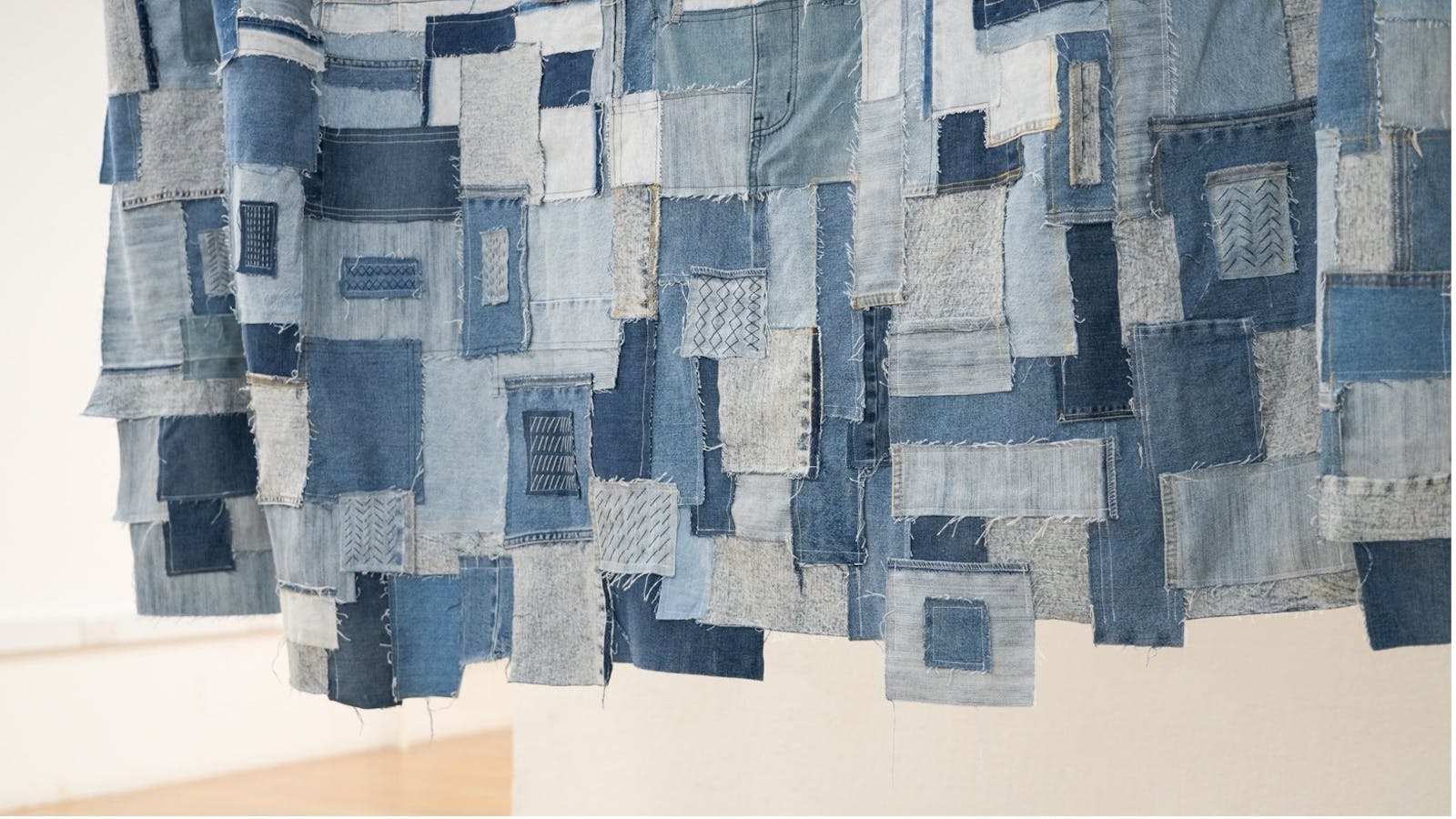
Fabrication Minion (2024) exhibited in Co-creating With Nature Exhibition, 13 May 2024 to 17 May 2024, Upper Gulbenkian Gallery, Royal College of Art, London
The Dialectical Relationship
When considering the materiality of theme park costumes, our attention is naturally drawn to the vibrant fabrics - the outside - which take centre stage in the spectacle. They are the parts being seen. However, if we delve deeper into the inside, we find that many large-scale character costumes are supported by hidden frameworks, with some structures made of metal. While fabrics embody the labour of those who design, make, and maintain the costumes, metals, on the other hand, might leave a deeper impression on those who dress and perform in the costumes. These are harder and heavier parts that support, encase, and protect but also exert pressure, constrain movement, and cause discomfort.
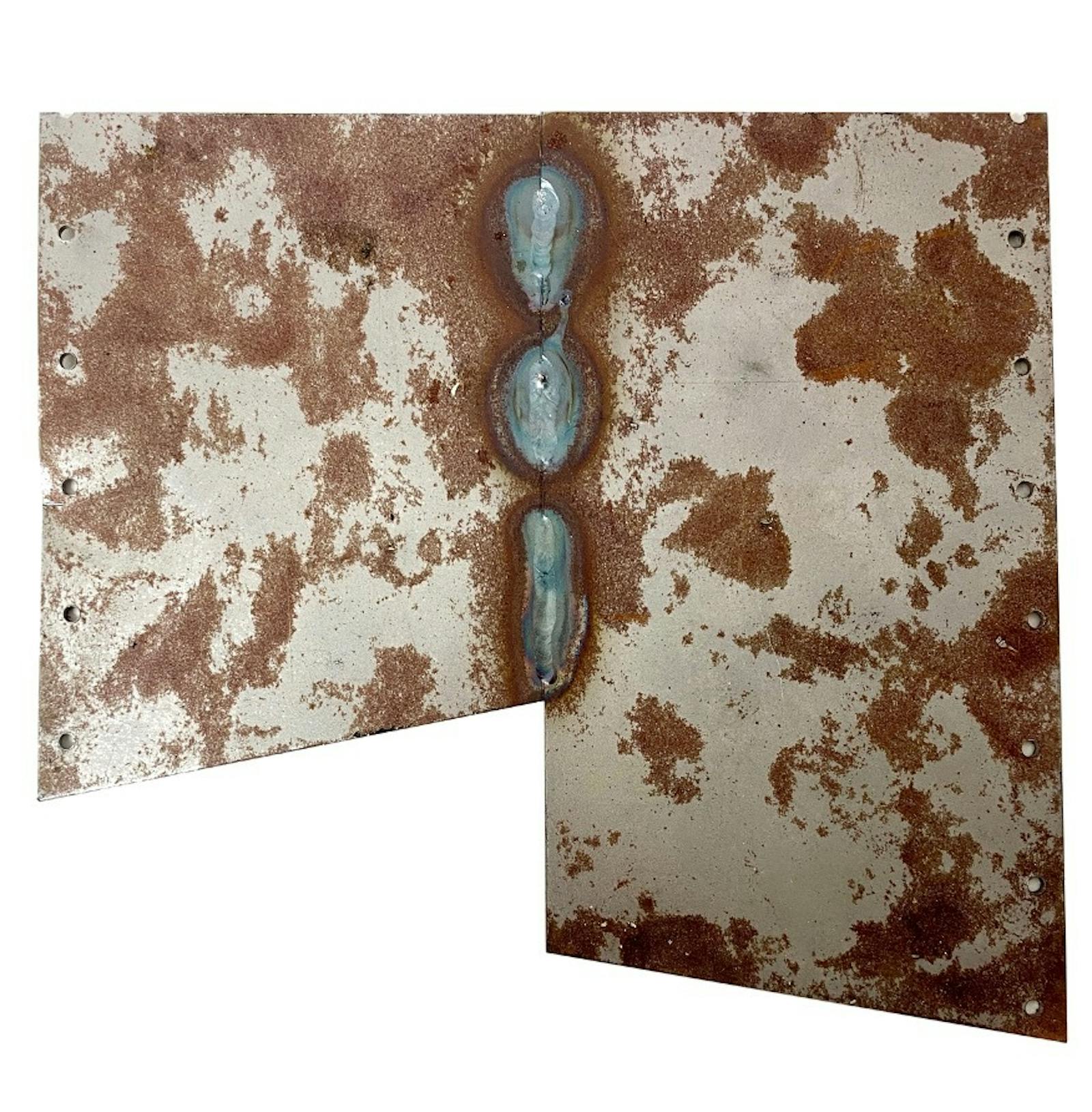
Patches (2024), rusted steel, 15 x 20 cm
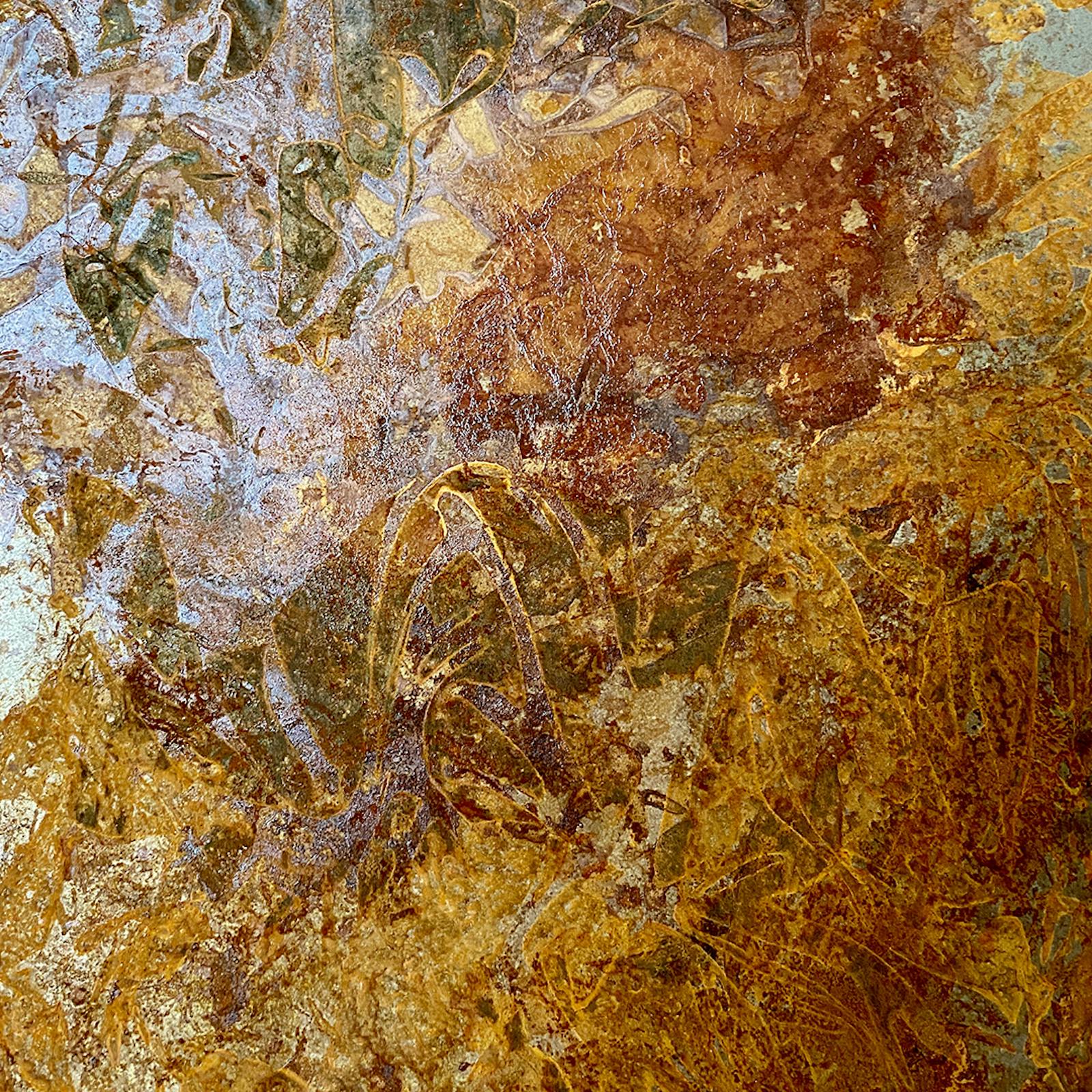
Gleaming Facade, Hidden Decay - Detail (2024), rusted steel, 42 x 60 cm
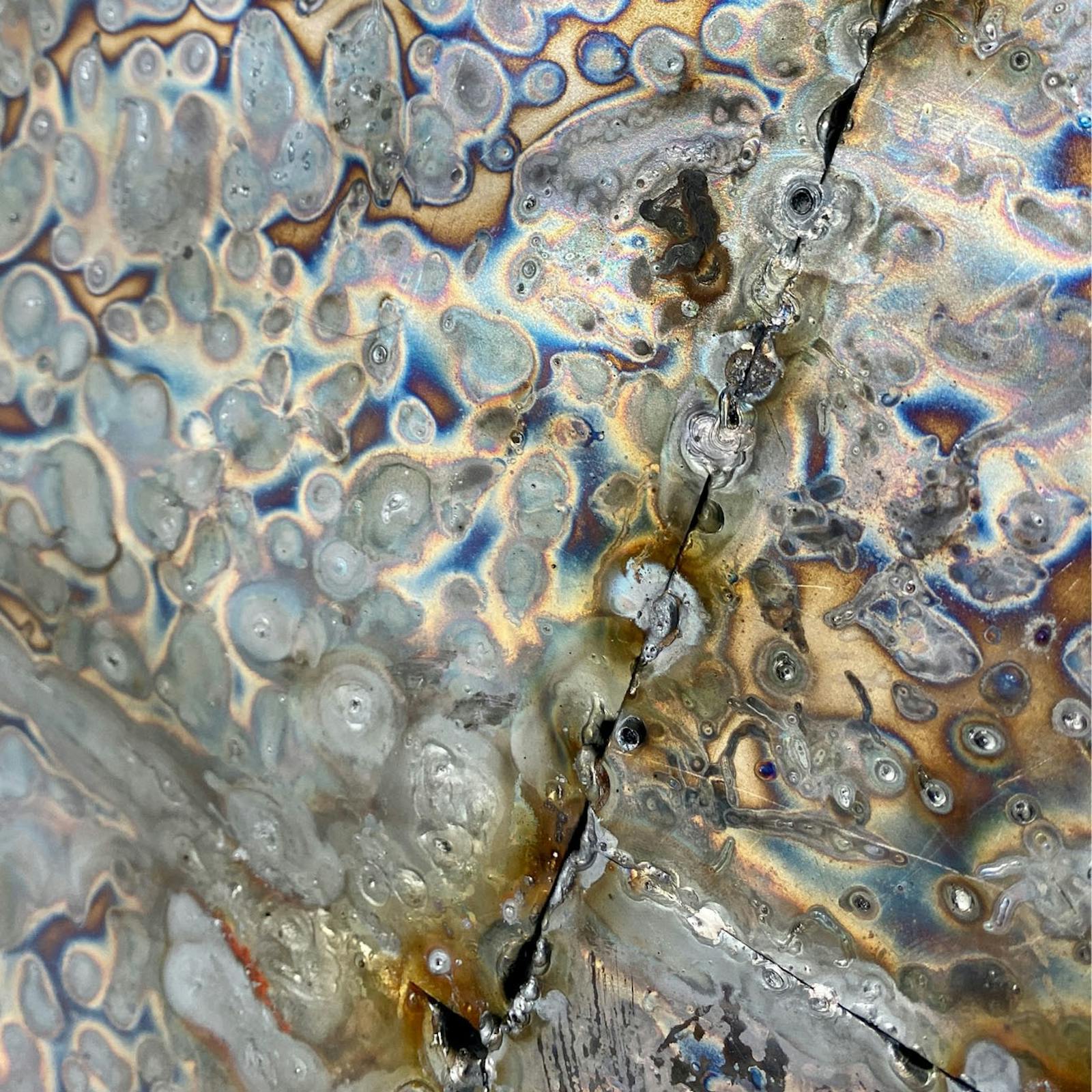
Before It Fade - Detail (2024), welded steel, 50 x 60 x 5 cm
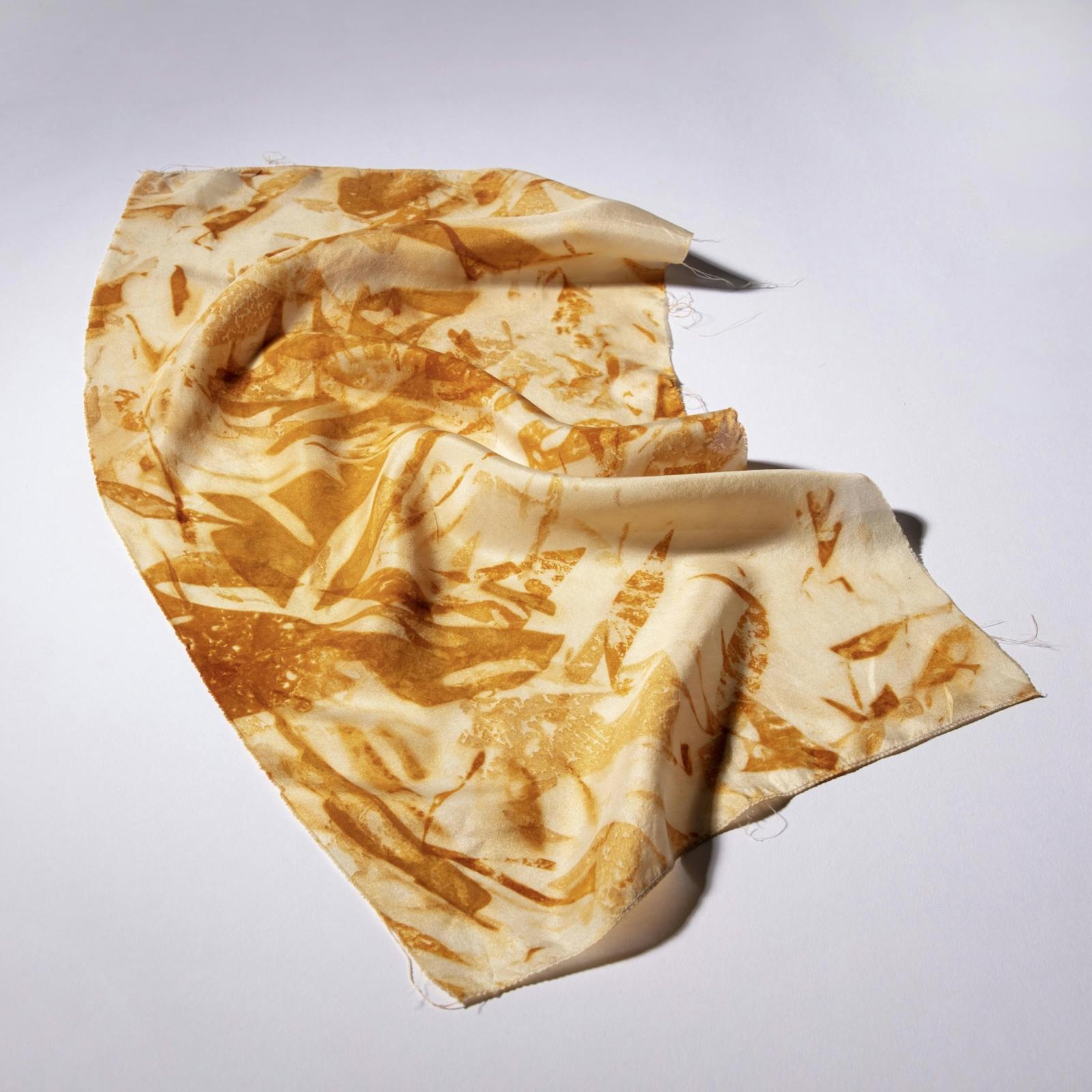
Rust Endures (2024), rust print on silk, 45 x 20 cm
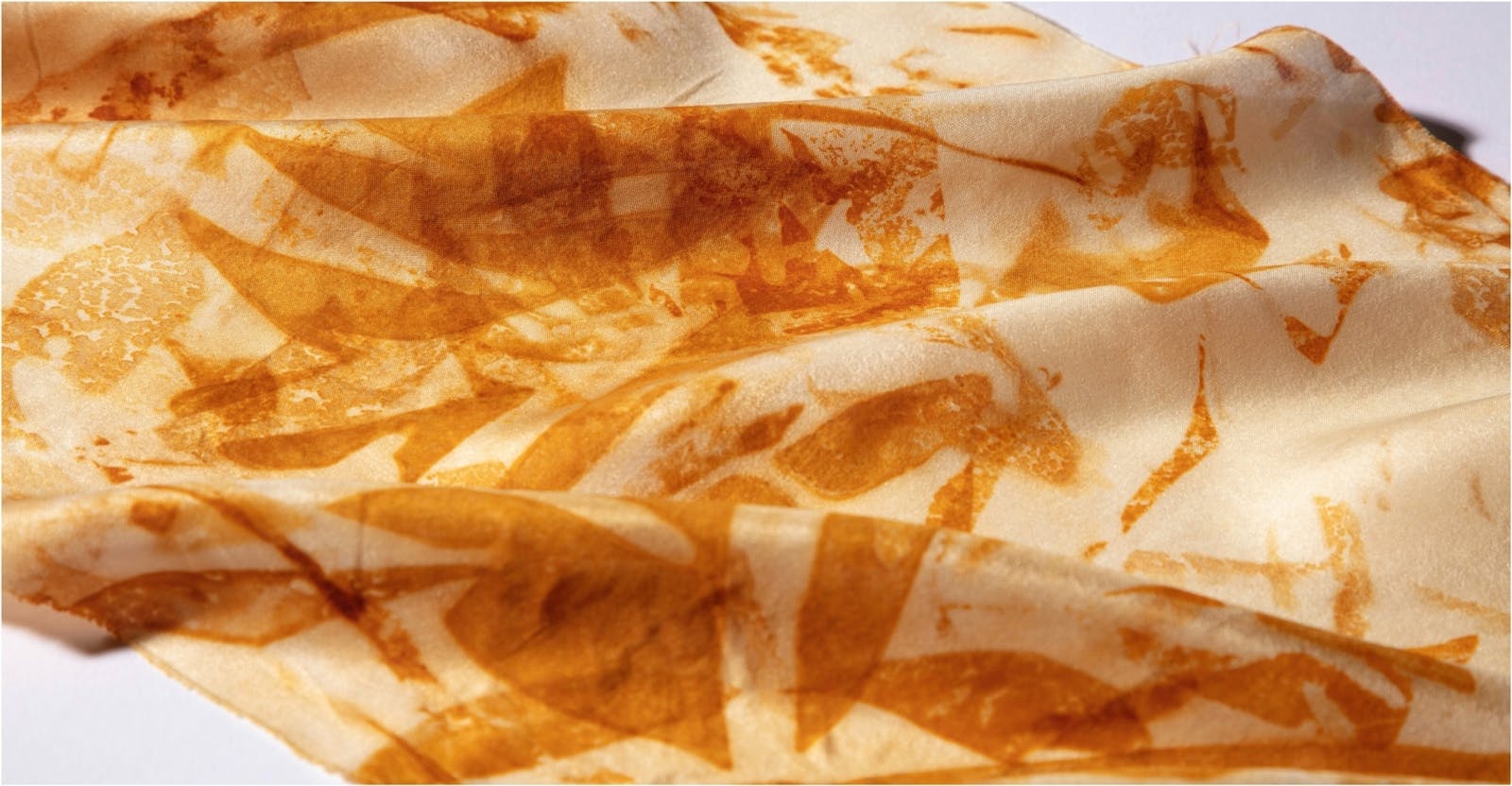
Rust Endures - Detail (2024), rust print on silk, 45 x 20 cm
Metal embodies both energy and stability, turbulence and calmness. Its duality captivated me. It bent, broke, rusted, and did not easily conform to fabrication. The juxtaposition of fabric and metal revealed a dialectic between fragility and strength, human agency and material limitation, and ephemerality and permanence. By probing how fabric and metal interact, I gained a more concrete understanding of the interconnectedness of all things.
An Alternative Way of Conversation
The process of exploring various materials and making techniques led me to textiles monoprinting. This practice resonates with me for several reasons. The first is its non-repeatable nature, as indicated by the prefix ‘mono-’. In contrast with the principles of industrial reproduction, it brings the attention back to hand-made qualities. Moreover, the process encompasses painting, printing, steaming, washing, drying, and ironing; it results in outcomes that are not entirely controllable and often include accidents and flaws, or what I would call serendipities. Such unpredictability makes it ideal for exploration and experimentation. Lastly, the process’s vitality, rhythmicity and, most importantly, physicality. The labour-intensive yet gratifying and fulfilling process allowed me to fully engage both my body and soul, leading to a ‘state of flow’.
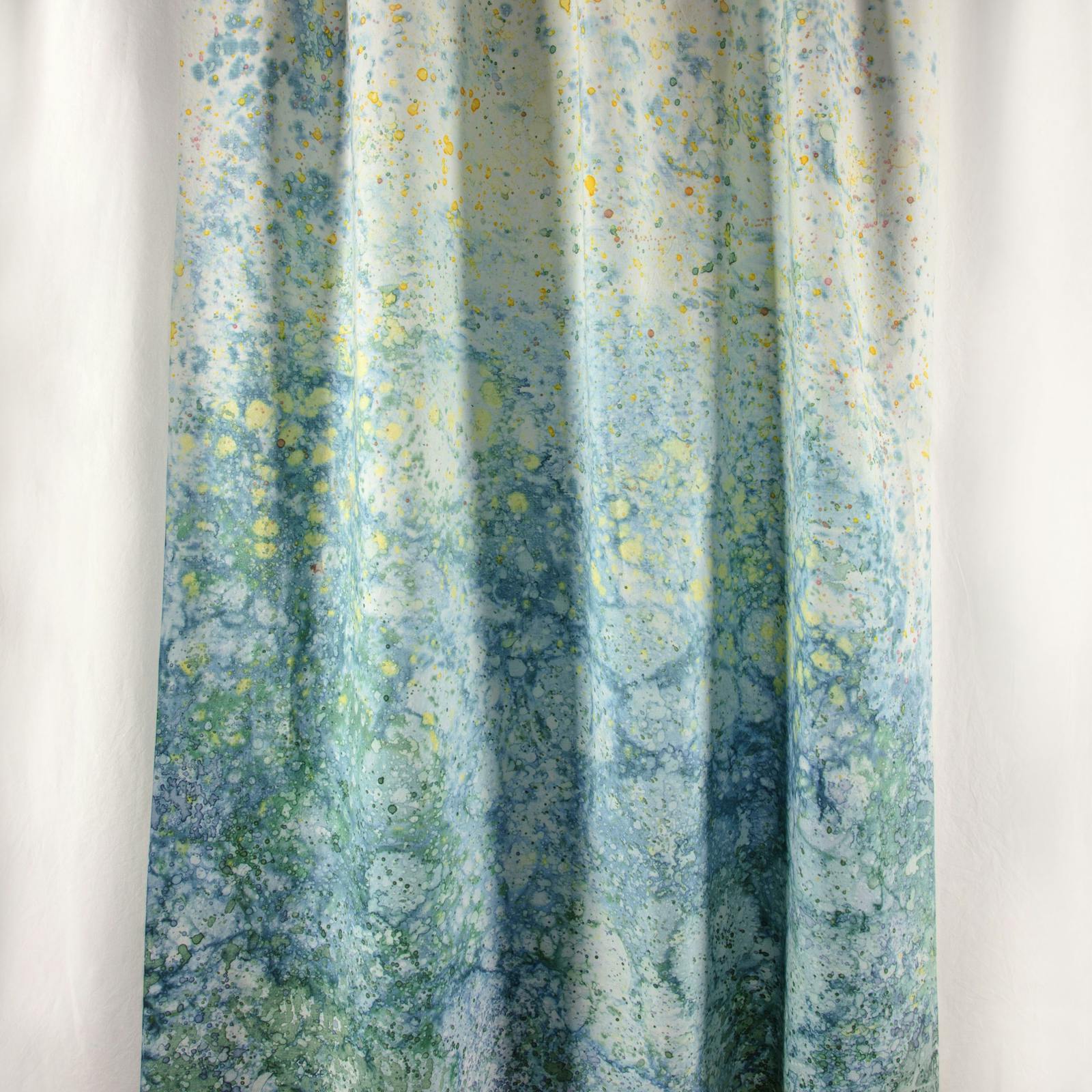
An Alternative Way of Conversation (2024), monoprint on cotton, 150 x 150 cm
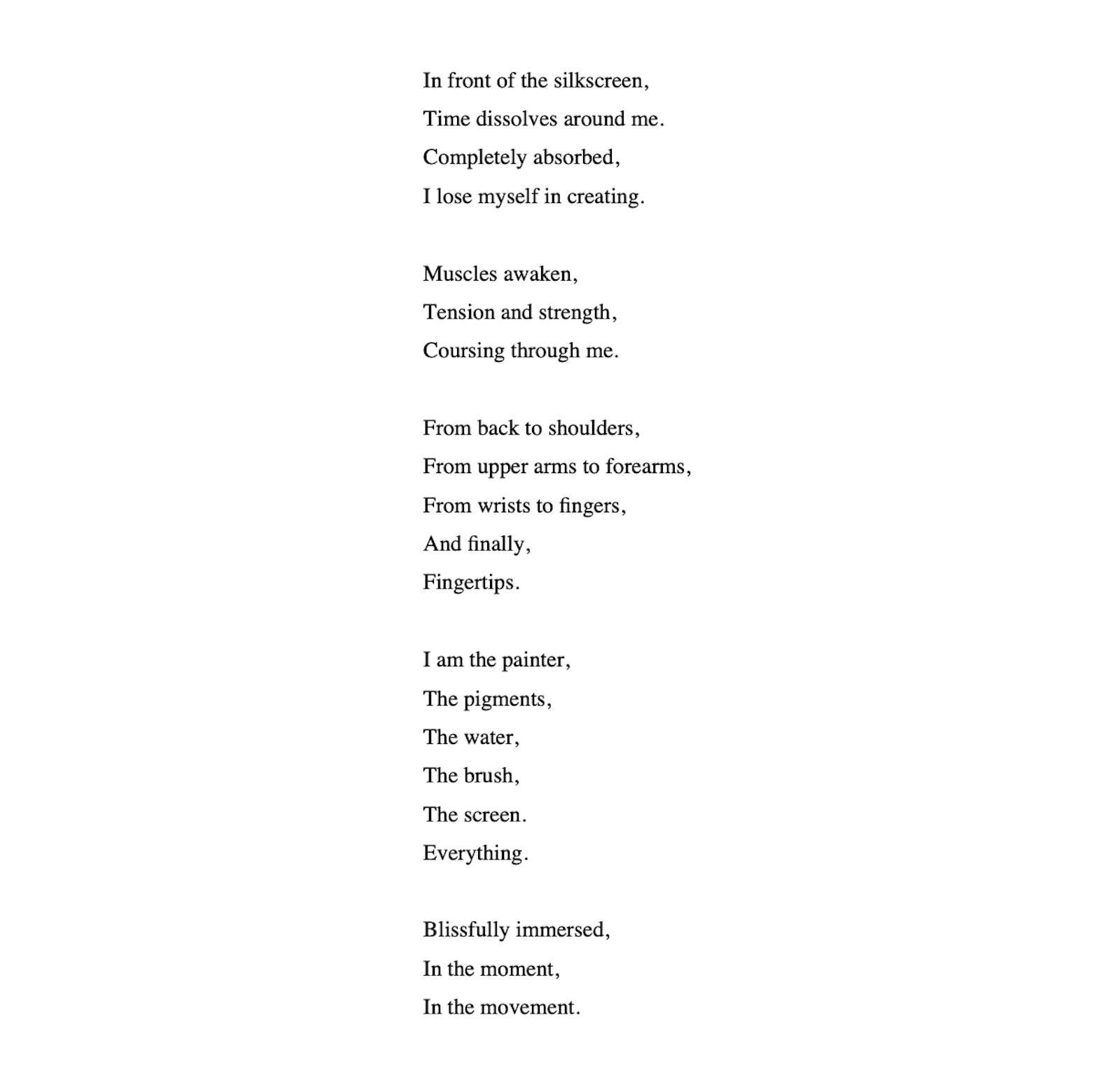
Through textiles monoprinting, I came to understand my limits, both physically and psychologically, as a human being. It guided me towards a more fluid, non-hierarchical, and collaborative creative approach to working with materials. Rather than imposing preconceived designs onto the materials, I developed the aesthetics and creative methods by diving into the process and conversing with the materials. I allowed the creative moments to shape and inform the outcomes. I splashed, sprayed, poured, dripped, and spilt, embracing the fluid qualities of the medium.
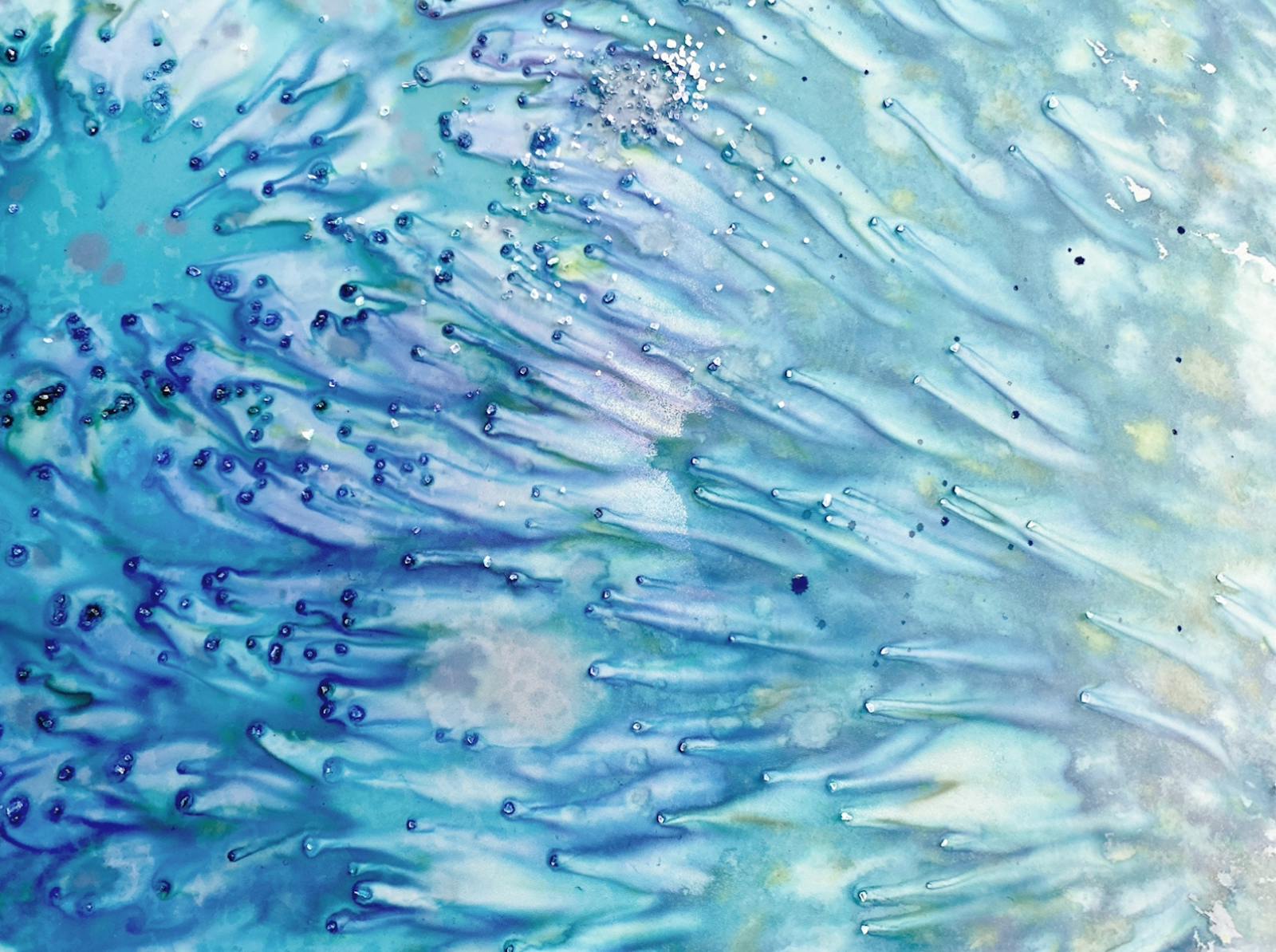
Textiles Monoprinting Work in Progress Documentation (2024)
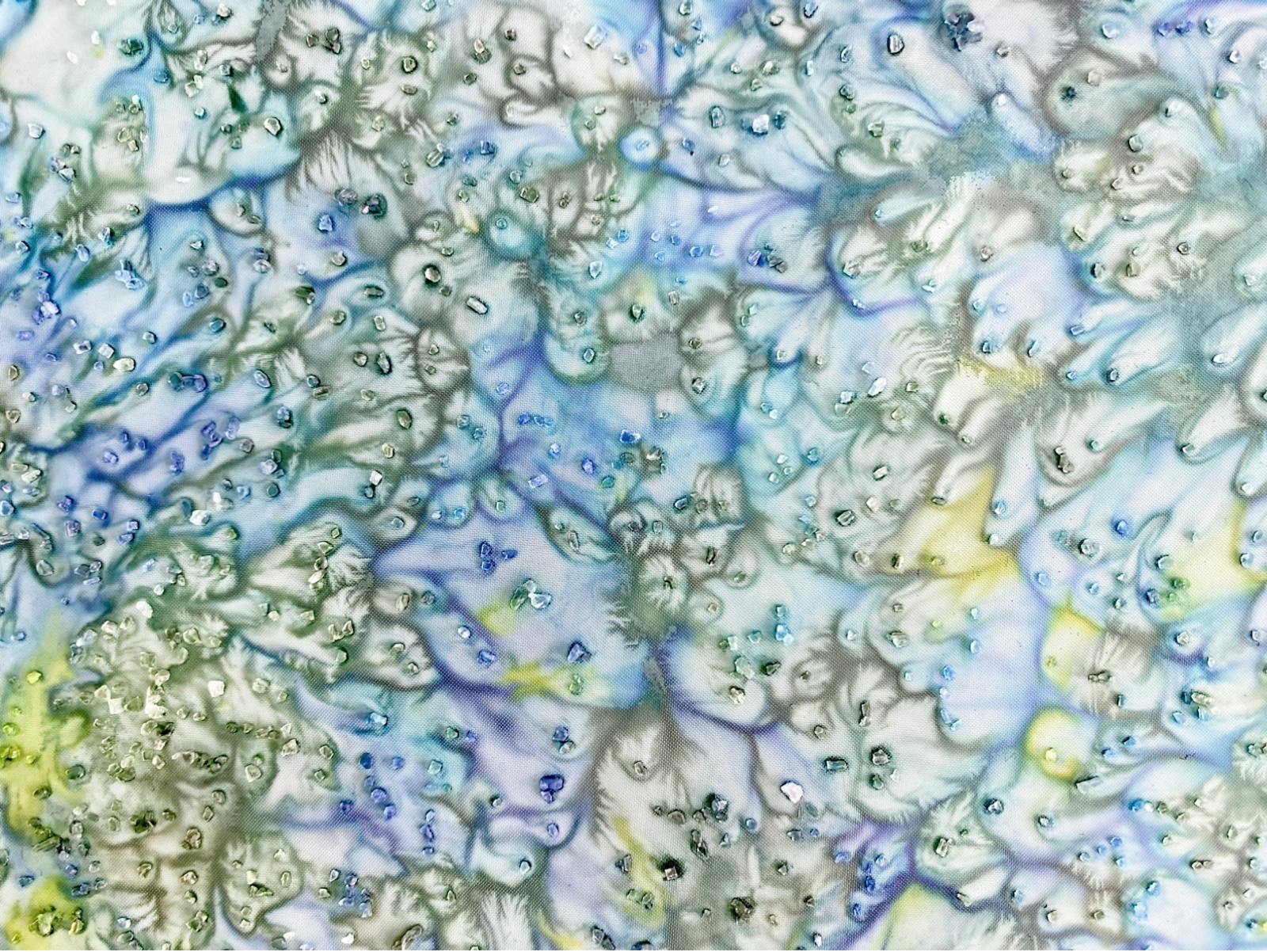
Textiles Monoprinting Work in Progress Documentation (2024)
The shift from a ‘solid’ to a ‘fluid’ approach in my art practice brings to mind Zygmunt Bauman’s concept of ‘liquid modernity’. According to Bauman, while ‘solids cancel time’, for liquids, ‘it is mostly time that matters’. Unlike solids, which are ‘cast once and for all’, ‘keeping fluid in shape requires a lot of attention, constant vigilance and perpetual effort’; therefore, shaping liquids ‘is easier than keeping them in shape’. Bauman suggests that in ‘liquid modernity’, traditional knowledge and expertise may become obsolete or irrelevant; this necessitates individuals to constantly learn, unlearn, and relearn in response to the changing social conditions. It highlights the importance of mobility, adaptability, and flexibility. However, Bauman also acknowledges the security and stability provided by ‘solid’ modernity - qualities often lacking in the ‘fluid’ state. I would argue that rather than repudiating the past structure, it is crucial to simultaneously reflect on the past while responding to and creating with the present moment - a process of ‘improvisation’ or ‘jazzing’.
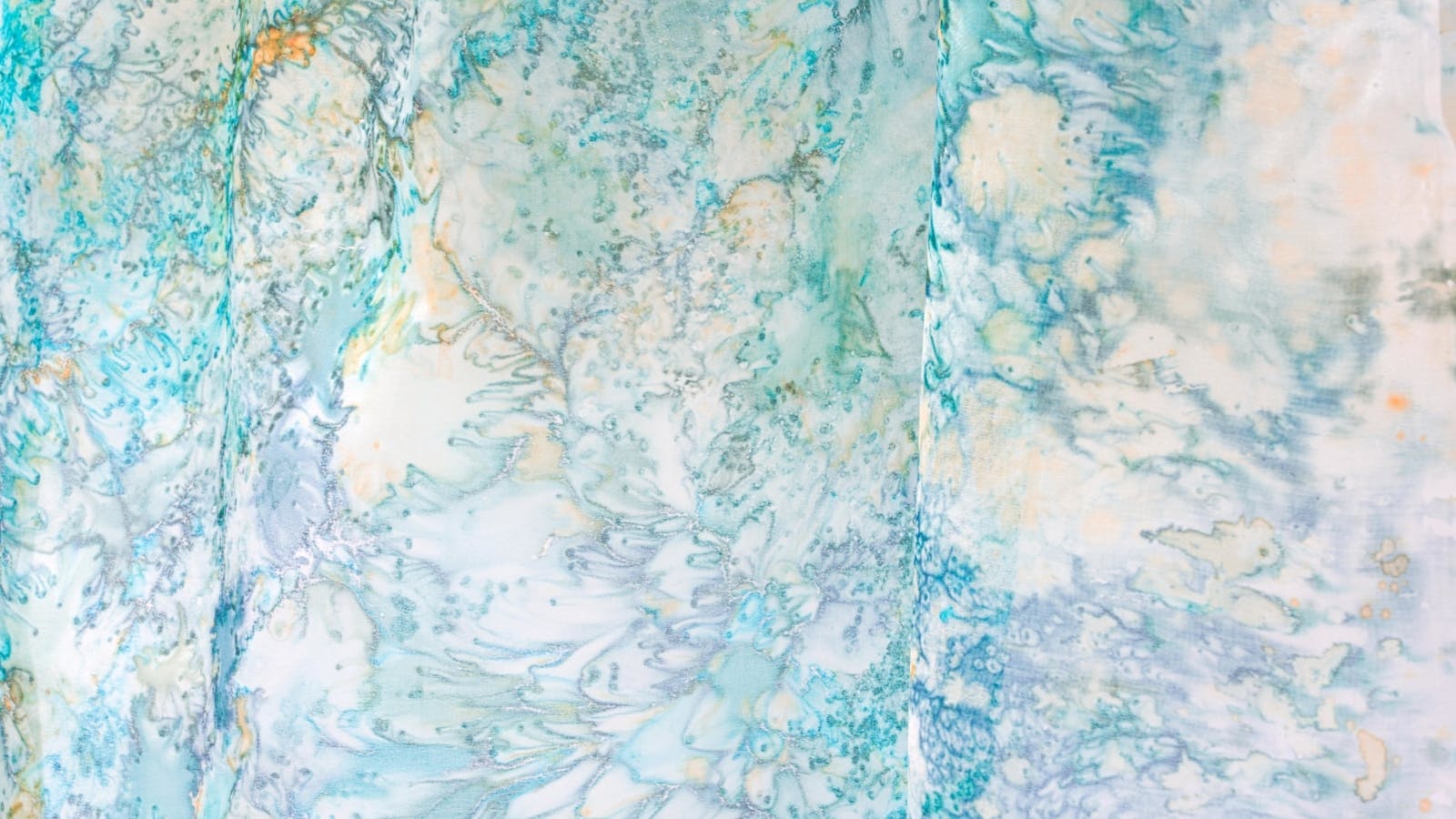
An Alternative Way of Conversation III - Detail (2024), monoprint on silk organza, 140 x 110 cm
A Space in Between and Beyond
Experiments with fabrics of various kinds - linen, cotton, and silk with different weaves, weights, textures, and finishes - guided me to explore ‘opaqueness’ both materially and conceptually. From a practical perspective, lightweight fabrics tend to be more suitable for monoprinting, as they absorb dyes and print paste more effectively and usually result in higher-quality prints. This insight guided me to choose translucent fabrics such as silk organza and cotton organdie. Conceptually, the term ‘opaque’ originally meant ‘dark, shaded, unlit’; it later evolved to include connotations such as ‘shady, dark, darkened, obscure’ and ‘hard to understand’. Instead of blocking the light with opaque materials, I hoped to let the light shine through, turning the obscure into the lucid.
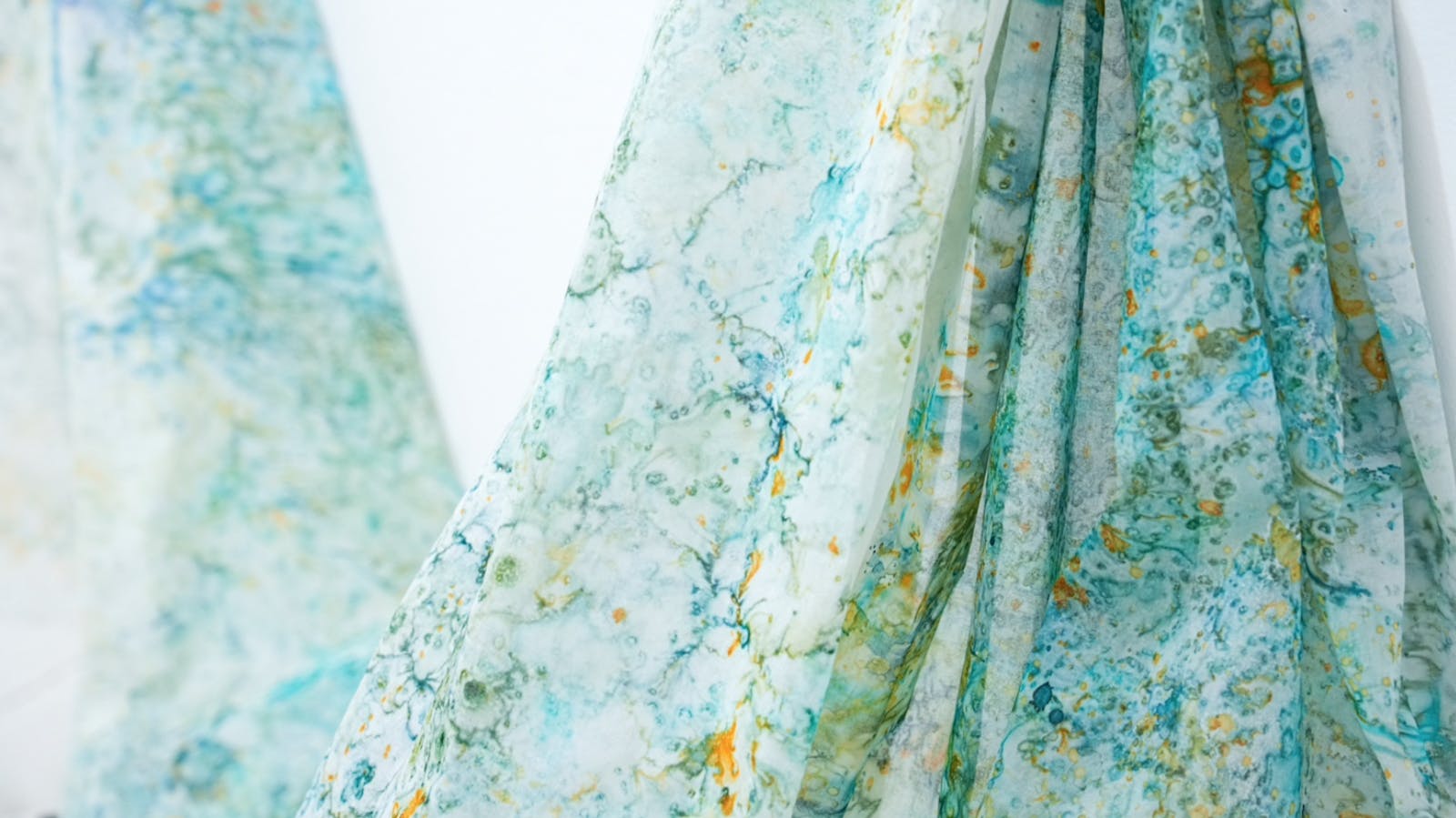
A Space in Between and Beyond (2024), monoprint on cotton organdie, 100 x 600 cm
On Unlearning and Not Knowing
In the over-saturated wonderlands full of spectacles, theme park costumes situate right at the junction where the surreal and the real, the abstract and the concrete meet; they embody both fantasy and labour. Here, theme park costumes serve as both physical artefacts and philosophical metaphors. This research draws an analogy between theme parks and the contemporary world, bridging the surreal and the real, the abstract and the concrete, as well as the theoretical and the practical. By putting myself through the life cycle of theme park costumes, the intensive and laborious creative processes effectively help transform ephemeral thoughts into continuous experiments, make the intangible tangible, and contribute to the articulation of ideas.
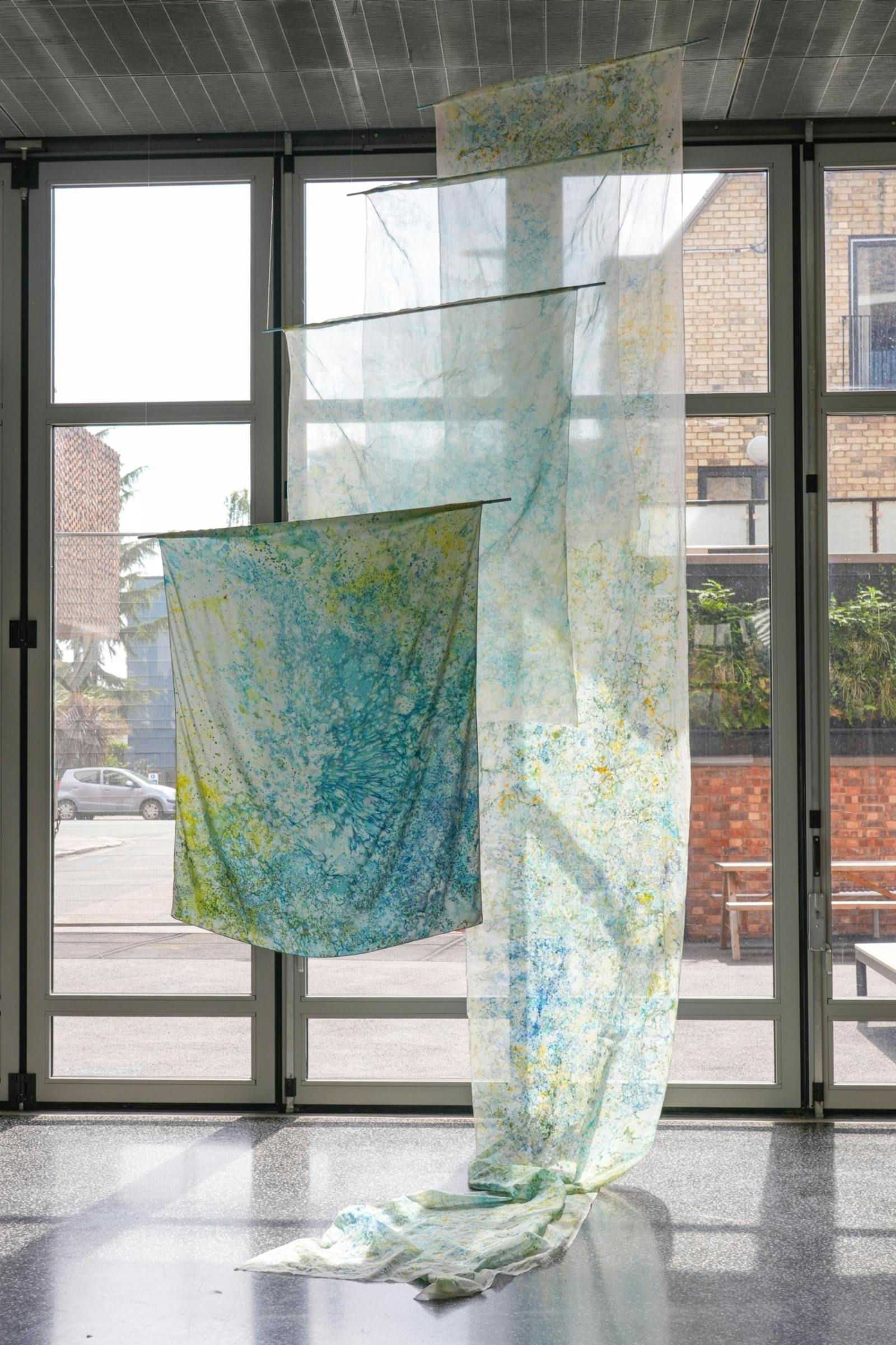
On Unlearning and Not Knowing (2024) exhibited in MRes RCA 2024 Research Journeys, 26 July 2024 to 1 August 2024, Curated by David Evans, Jonathan Miles & Esther Teichmann in dialogue with MRes RCA students, The Hangar Gallery, Royal College of Art, London
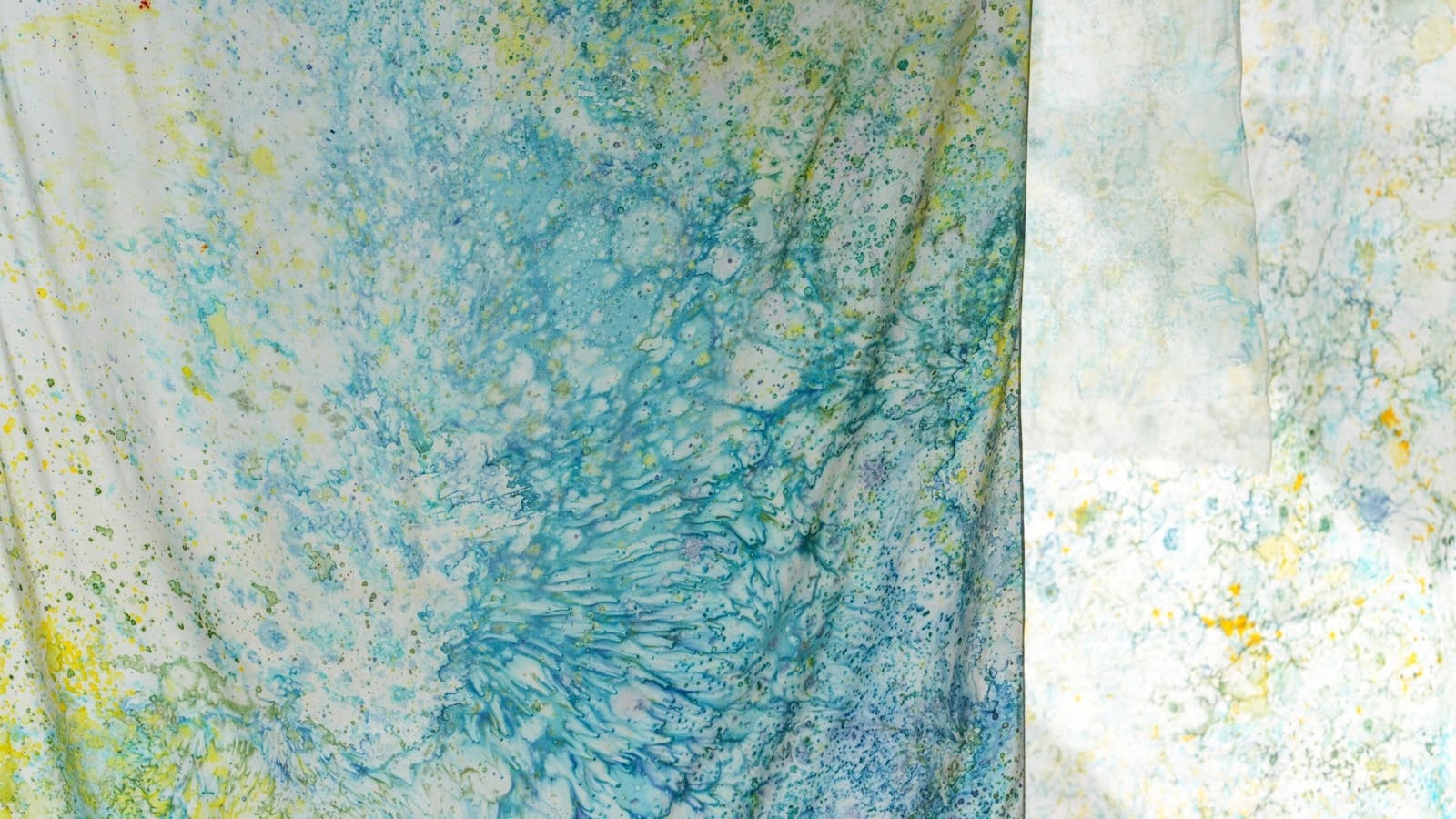
On Unlearning and Not Knowing - Detail (2024) exhibited in MRes RCA 2024 Research Journeys, 26 July 2024 to 1 August 2024, Curated by David Evans, Jonathan Miles & Esther Teichmann in dialogue with MRes RCA students, The Hangar Gallery, Royal College of Art, London
One of the most important insights I have gained from this project is comprehending the value of ‘not knowing’. Starting without a script, I embarked on the journey without knowing how the research would develop, what mediums I would use, which workshop I would work in, and where I would end up. This uncertainty was unsettling to me at first. However, the off-script journey allowed me to step away from the predefined path. It led me to an alternative space - a space where I could immerse myself fully, embrace the moments, and follow the processes. Resisting definitive interpretation, I explored the unknown with curiosity and humility, entering a space of wonder. In Rachel Jones’s words, ‘Not knowing constitutes on the one hand an inevitable effect of the perspectival limits that allow us not only to think, but to exist at all, as the temporarily individuated entities that we are; and on the other, a condition of becoming, of the possibility of the not-yet and still-to-be, without its emergence being overshadowed by what already is and has been.’
